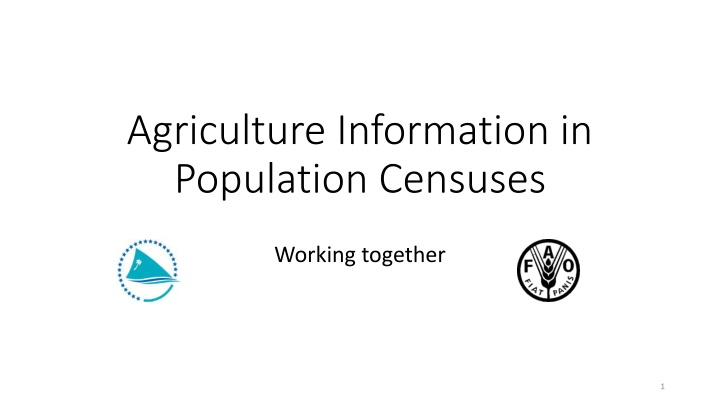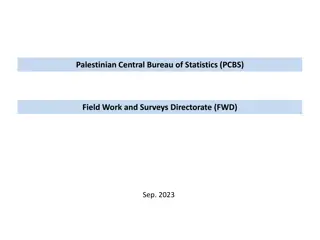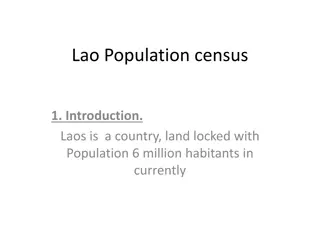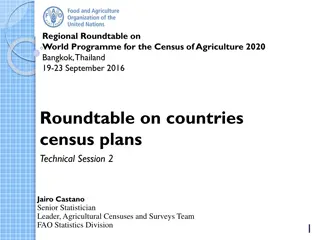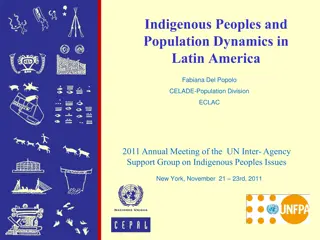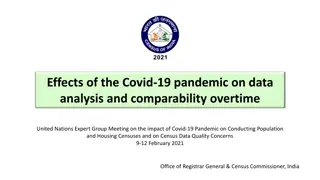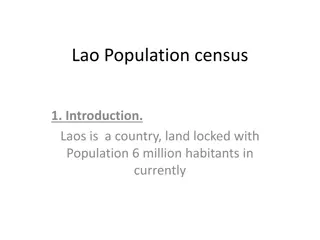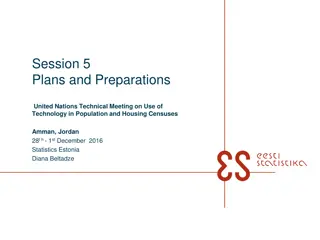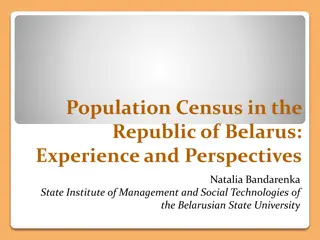Importance of Agriculture Information in Population Censuses
Agriculture data in population censuses is crucial for understanding socio-economic dynamics, food security, and rural development. It aids in policy analysis, demographic insights, poverty reduction strategies, gender roles, and overall development monitoring. Utilizing existing agriculture information enhances data quality, informs development strategies, and enables efficient household enumeration and area selection for surveys.
Download Presentation

Please find below an Image/Link to download the presentation.
The content on the website is provided AS IS for your information and personal use only. It may not be sold, licensed, or shared on other websites without obtaining consent from the author.If you encounter any issues during the download, it is possible that the publisher has removed the file from their server.
You are allowed to download the files provided on this website for personal or commercial use, subject to the condition that they are used lawfully. All files are the property of their respective owners.
The content on the website is provided AS IS for your information and personal use only. It may not be sold, licensed, or shared on other websites without obtaining consent from the author.
E N D
Presentation Transcript
Agriculture Information in Population Censuses Working together 1
Agriculture data is an important socio- economic variable Three out of four poor people in developing countries live in rural areas Smallholders (most vulnerable) rely primarily on fishing and agriculture for their subsistence. Agriculture (incl. fisheries) plays a key role in food security and employment. Agricultural development is vital to achieving the Millennium Development Goals And will also be vital to achieving the Sustainable Development Goals particularly those related to poverty and food security and to environmental sustainability 2
Agricultural and Rural Statistics The need to measure agricultural performance and the results of agricultural investment has become an increasingly pressing priority A wide range of important policy issues depend on good quality agricultural and rural statistics Improvement of coverage/availability of agricultural statistics badly needed for informed decision-making on rural development and food security Data collected in Censuses may be the only information, and the most reliable 3
Uses of existing agriculture information in Pacific censuses Policy analysis Demographic analysis - the agricultural status of a household can help explain fertility differentials. Vulnerability and poverty analysis how does subsistence agriculture contribute to poverty reduction? Gender analysis was is the role of women within the agricultural household? Census data can allow analysis of the interactions between socio-economic factors Informing and monitoring development strategies Good policy analysis results in good planning Data helps to monitor indicators of development at the local, national regional and international level. Census is usually the main source of information for local planning, village directories Analysis of interactions often needs access to micro-data at the individual/household level and good metadata 4
Listing of households, and enumeration areas Standard use to select enumeration areas, listing of households for future surveys With a few more questions, the sample can be optimised costs reduced, accuracy improved. And data can be linked to census, to reduce the need for some questions and potentially get small area estimates 5
Agricultural analysis links to/ includes Gender Age Education Income Work Status in employment Health/nutrition Small area info Disaster risks Climate change risks 6
Agriculture/ fishing topics - needed for sample frame Agriculture production of crops Agriculture livestock production Agriculture forestry? Fisheries capture-based Fisheries aquaculture (freshwater and saltwater) Hunting land based (coconut crabs present a problem here as they re managed under fisheries)? Handicrafts/local food processing? Purpose of production and measures of size 7
Agriculture Statistics Developments (FAO and SPC working together) Supporting agriculture statistics developments Linking population census and agricultural census Core questions, based on FAO World Census of Agriculture 2020 recommendations, developed for Pacific needs Role of the Global Strategy in Improving Data on Agriculture and Rural Sectors An initiative of the United Nations Statistical Commission Partnership between International Agencies, developed and developing countries involving an extensive consultation process 8
Do we need a Pacific strategy for Agriculture statistics? Basic data requirements are not being met, countries capacity in agricultural statistics has declined since early 80s both collection and use of data there are a declining number of countries reporting basic production data declining resources are being allocated to agricultural statistics by countries and development partners (low priority) Agricultural statistics are not integrated in the National Statistical System (NSS) lack of coordination between NSO & Min. of Agriculture duplicated efforts in data collection conflicting numbers National Statistical Plans need to include agricultural statistics Emerging data needs (impact of agriculture on environment; investment in agriculture; food commodities use in biofuels; water and land use, climate change, etc.) Need for a new conceptual framework Currently we lack a sound basis for agricultural development, Food Security policy formulation, implementation, monitoring and evaluation 9
Proposed Pacific Strategic Plan on Agricultural Statistics Strategy would build on TYPSS, country NSDS and census planning activity to focus on how existing censuses and surveys being conducted in the region can be leveraged for stronger agricultural and rural statistics (looking at Population census and HIES in particular) It would provides as long term plan covering technical assistance, research and training Proposed workshop in October this year to i) introduce stakeholders to next round on WCA and research globally and from the region and ii) conduct a roundtable on the need for a Pacific agricultural statistics strategy 10
FAO e-learning course on linking population and housing census with agricultural census 11
Options for Census Options for Census Integration http://www.fao.org/elearning/#/elc/en/course/STAT Integration Population and Housing Census Basic questions only Agriculture Census Separate uses enumeration areas and listing Smaller Census, some linked Sample-Surveys More options for analysis, reduced need for additional collections At the same time, sharing some resources Add sample frame questions Add optional questions Joint Censuses Common modules, for Censuses and other surveys, providing consistent information more often 12
Agriculture information is needed The need to measure agricultural performance and the results of agricultural investment has become an increasingly pressing priority A wide range of important policy issues depend on good quality agricultural and rural statistics 13
